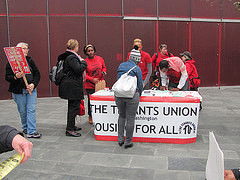
In November, about 200 tenants of SHA buildings marched down Queen Anne Avenue to protest, then descended on the regularly scheduled SHA Board of Commissioners meeting, and spoke out about fears of displacement and homelessness if the plan were to be implemented.
Commented TUWS leader and public housing resident Lynn Sereda, “We do remain vigilant, but consider this to be a victory for tenants, and our attention is now focused on making sure that the new appointments to the Board of Commissioners of SHA will be accountable to tenants and that we will have a voice in that process.”
In a December 16th letter to Mayor Edward Murray, SHA Executive Director Andrew Lofton cited the fear among tenants that, “there were many questions and concerns about the availability of living-wage jobs for low-income people.” The agency opted to step back from Stepping Forward and anticipated that it would not bring an alternative rent proposal forward until 2016.
If adopted, Stepping Forward would have jettisoned the traditional public housing rent formula, where a tenant pays 30 percent of her income for rent, in favor of a Stepped Rent policy. Today, if a Seattle tenant earns the minimum wage of $9.32 an hour and works 40 hours a week, she will pay approximately $497.00 in monthly rent. If the tenant becomes unemployed or has their hours reduced, rent is decreased. Tagging rents to a portion of income is an effective method of preventing homelessness, especially for those who work in the service industry where protections for workers are scarce. Under the proposed plan, it would have eventually taken at least $16.00 an hour wage to pay Housing Authority rents.
SHA Deputy Director Anne Fisk Zuniga outlined the philosophy behind the program. “We believe in self-sufficiency, and that public housing and Housing Choice Vouchers should be a stepping stone in people’s lives rather than the ending point. Stepping Forward includes a workforce assistance element that will help residents prepare and aim for higher paying jobs. With better paying jobs, people would be able to pay the increased rents contemplated in Stepping Forward.” Zuniga made it clear that SHA believes that higher rents are the incentive needed to encourage long-term unemployed tenants to find work.
SHA proposed to increase the rents for up to 7,000 households deemed “work-able.” The program’s stated goals were to encourage residents to take employment—and exiting public housing—seriously. According to their data, about 60 percent of SHA households already have at least one breadwinner earning an average of $22,050 annually. Tenants are also moving out of public housing on their own as the average stay in the system is eight years. Many tenants are already doing what SHA wants them to do: use time in public housing as an opportunity to stabilize one’s life and then move on.
An op-ed in The Seattle Times said Stepping Forward's “assumption that better-paying, low-skilled jobs can be found rings false at a time when working-class wage stagnation and income inequality are among the region’s top concerns.” There were serious doubts that Seattle’s economy could produce the kinds of living-wage jobs that the SHA wants its tenants to find.
Remarked Denechia Powell, lead organizer at TUWS, “Tenants who are able to secure living-wage employment would benefit from below market-rate rents under Stepping Forward, but the tenants union is most concerned about tenants who would continue toiling in minimum-wage jobs and searching for work in our post-recession economy. 60 percent of the 7,000 tenants who would be impacted by Stepping Forward are already working, while other tenants are enrolled in workforce training provided by SHA and still cannot obtain a job.”
The driving force behind Stepping Forward was the dire state of federal support for public housing. Seattle lost 12 million federal dollars last year, and with the current Republican majority in Congress, more cuts are likely to come. This created a situation where the interests of current public housing tenants were pitted against those of the over 9,000 people on the waiting list for housing assistance. Zuniga explained, “An unacceptable number of people languish on our waitlists, and with revenues generated from increased rents through Stepping Forward, we would be able to serve at least 600 additional families.”
So what’s next? It is clear that without an end to federal cuts to public housing, a revised Stepping Forward proposal is on its way. Federal austerity will continue to push even the most liberal local administrations to pit the housed against the homeless for the same scarce resources. By winning some breathing room, the coalition that defeated the program will have time to strategize on what a long-term plan for housing and grassroots economic development in Seattle should look like.
(Photo credit: “SHA Stepping Forward Protest” by Flickr user javacolleen, CC BY-NC-ND 2.0)






Comments